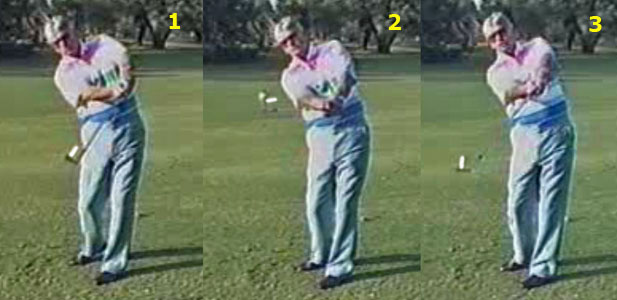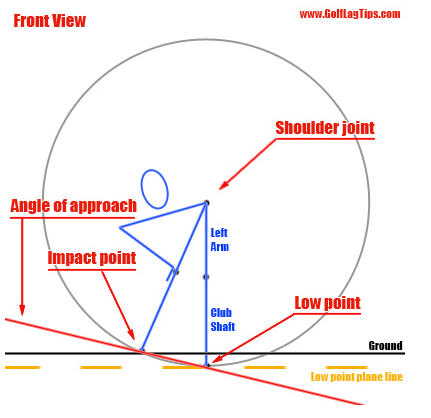
2-J-1 (Impact Alignments)
Homer Kelley states in order to get consistent impact alignments, you have to prepare for those correct impact alignments. In order to prepare for them, you need to establish what the correct impact alignments are.
First, the clubface must be square to the Target Line at seperation (the point just after impact where the ball 'seperates' from the clubface) if you want to hit a straight shot.
Secondly, the clubface alignment at Impact Fix must fit the hinge action selected. Remember, impact fix is the chosen alignments of the hands, clubshaft, clubface at address. Here's a video of Simon Williams performing impact fix (he has his hands at 'impact hands' at address, but you can also use 'mid-body' hands at address as well)
And here's the Tomasello pic again showing the 3 different hinge motions. (1=angled, 2=horizontal, 3=vertical)

Because the toe is pointing at the target with horizontal hinging, which means the clubface is closed quite a bit thru impact, Homer suggests opening the face a little at impact fix to allow for that closing. And yes, GENERALLY speaking the horizontal hinge action produces a draw spin and usually well executed 'swinger' patterns tend to hit draws. Homer also states that with horizontal hinging, it's recommended that the longer the shot, the more open the face should be at impact fix.
With Angled Hinging, Homer recommends an open face on the shorter shots and a closed face on longer shots. And with Vertical Hinging, no clubface alignment adjustments need to be made regardless of the length of the shot.
A couple of other important notes are made. In particular, the clubhead should hit the ball FIRST and THEN take a divot. Here's a KJ Choi SwingVision video showing Choi doing just that.
Lastly, Homer notes that the golfer is likely to see themselves, 'rise' upward when they get to impact...particularly with the driver. What this means is if you sole the club with a driver, you're likely to rise up towards the teed ball so you can hit it properly on the sweetspot. So what Homer Kelley is saying that with a driver you should play the ball more towards the toe of the club. Here's a link to a video by John Graham showing what Homer Kelley was talking about when it came to addressing the ball towards the toe of the club with a driver. Addressing With The Driver Video
Homer states that this method of addressing the ball towards the toe with the driver allows for more precise geometric alignments. With irons it doesn't need to be so much off the toe because you are hitting downward.
2-J-2 (Low Point)
One of the most important parts of TGM is in 2-J-2. Thankfully, it's pretty easy to understand.
Going back to the 'Geometry of the Circle' in the diagram below:

The low point is simply the 'lowest point' of the clubhead as it travels on the Geometry of the Circle. It should also be noted that the 'Low Point' is straight down the line from the left shoulder. It's like that with all golfers (except it's the right shoulder if you're a lefty).
The first KEY is to have the ball position behind the low point. This allows the golfer to hit the ball FIRST, THEN take a divot which means the golfer can properly compress the golf ball. If you get the ball position too far forward up by the low point, then you're more likely to take a divot FIRST and then hit the ball, which results in poor shots. One of the big reasons why 'flipping' (aka a bent left wrist at impact) is a problem is that it moves the low point around. If you 'flip' the low point will move further back in your stance, but it's tough to figure out where the low point will be. If your left wrist is flat, the low point will always be opposite of the left shoulder.
3JACK
4 comments:
3Jack
This is really good stuff. Thank you for sharing.
PChandler
Great posts. Do you know WHY Homer recommends changing address impact positions....
e.g....for angled hinging.....open for short shots, closed for longer shots?
This seems like it could lead to inconsistencies? Do you do this?
Thanks.
I don't do it, but it has to do with how the face closes. With angled hinging the face won't close to square at impact as easily on long shots. With horizontal hinging, centrifigul force causes the clubface to close quickly. Has a lot to do with the force applied to the swing. Again, it's recommended, not mandatory. But that's the beauty of TGM, lots of recommendations, very few things that are mandatory.
Great posts. Do you know WHY Homer recommends changing address impact positions....
e.g....for angled hinging.....open for short shots, closed for longer shots?
This seems like it could lead to inconsistencies? Do you do this?
Thanks.
Because of the difference in ball position!!
Post a Comment